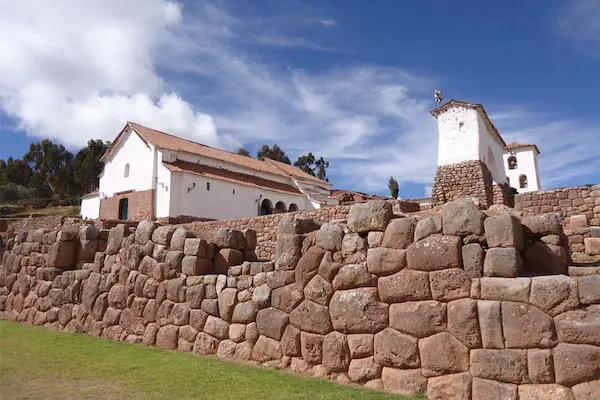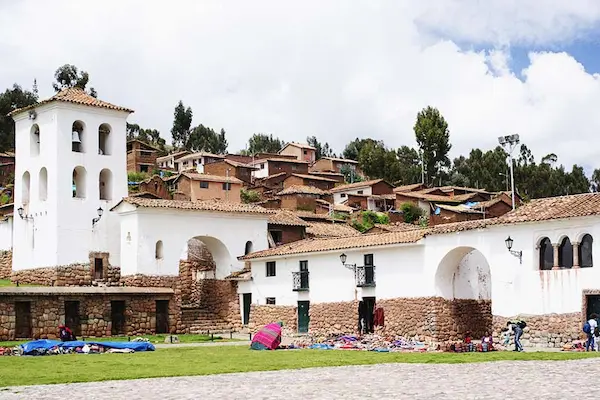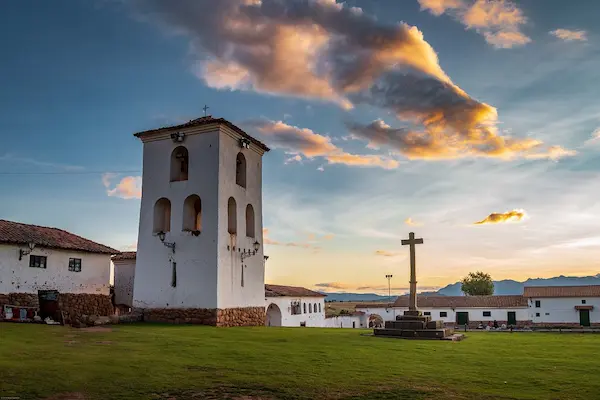Av Retamayoc L-10, San Sebastián 08002
- +51 940 809 144
- Travel Blog
- About Us
- Contact Us
Av Retamayoc L-10, San Sebastián 08002
Chat to a Andean Road Peru
Nestled high in the Andean mountains, Chinchero is a small town that offers a unique opportunity to experience the vibrant living culture of the Inca civilization. With its rich history, stunning landscapes, and strong ties to traditional Andean practices, Chinchero is a must-visit destination for anyone seeking to connect with Peru’s indigenous heritage. This article explores the significance of Chinchero, its cultural importance, and the experiences that await travelers who venture to this remarkable town.
Maybe you’d like to read: Visiting Pisac ruins: A Journey through history and culture

Chinchero, located about 28 kilometers from Cusco, holds a significant place in Peru’s history, particularly within the Inca Empire. The town is believed to have been an important agricultural center during the time of the Incas, known for its terraced fields and its strategic location within the Sacred Valley. The area was once favored by the Inca emperor, Tupac Inca Yupanqui, who is said to have built a royal palace in Chinchero, evidence of which can still be seen in the remnants of its terraces and walls.
The town’s deep connection to Inca culture is most evident in the archaeological site located just outside the main plaza. Visitors can explore the remains of Inca walls, temples, and agricultural terraces that reflect the advanced engineering and agricultural knowledge of the Incas. The site is a reminder of the town’s role as a vital hub for trade and commerce during the Inca period.
One of the most striking features of Chinchero is its colonial church, the Church of Our Lady of Monserrat, built atop an Inca temple's foundations. The church’s facade, adorned with beautiful baroque-style artwork, showcases the blending of indigenous and colonial influences. Inside, the church houses an impressive collection of colonial-era paintings and religious art, offering a fascinating glimpse into the fusion of cultures that shaped Chinchero.
What sets Chinchero apart from other archaeological sites in Peru is its living culture. Unlike many Inca sites preserved as historical monuments, Chinchero remains a vibrant community. Here, traditions, customs, and ways of life passed down from the Incas are still very much alive.
The town is home to a small but lively indigenous population, primarily descendants of the Inca civilization. The people of Chinchero practice traditional farming techniques, cultivating native crops like quinoa, potatoes, and maize. Farmers use methods passed down from Inca ancestors, such as terracing and irrigation systems. These techniques have lasted for centuries.
In addition to farming, Chinchero’s residents are known for their weaving traditions. The town is famous for textiles made from alpaca and sheep wool. Weaving has passed down through generations. Visitors can see this ancient craft in action. Local women, dressed in traditional clothing, weave intricate patterns on handlooms. They create vibrant textiles sold in the town’s market. These textiles feature symbols with spiritual or cultural significance. This reflects the deep connection between Chinchero’s people and their heritage.
The town’s market, held every Sunday, is an excellent place to experience the living culture of Chinchero. Here, visitors can find a wide variety of handmade textiles, pottery, and jewelry, all crafted by local artisans. The market is a lively and colorful affair, where locals gather to sell their goods, exchange news, and socialize. It is also a place where visitors can engage with the community and learn about the customs, traditions, and daily life of the people of Chinchero.
Maybe you’d like to read: The History of Tambomachay: The Inca Water Temple

In addition to its rich cultural heritage, Chinchero offers stunning natural landscapes. The town sits at 3,762 meters (12,343 feet), providing breathtaking views of the snow-capped Andes peaks. The area features terraced fields, small villages, and winding rivers. This picturesque setting invites hiking, photography, and nature walks.
One of the most popular ways to explore the natural beauty of Chinchero is by taking a hike along the Inca Trail, which passes through the town. This ancient trail, which was once used by the Incas for trade and communication, offers hikers a chance to walk in the footsteps of their ancestors while enjoying spectacular views of the surrounding mountains and valleys.
The area around Chinchero is also home to several beautiful lakes, including the shimmering lake of Piuray, located just a short distance from the town. The lake is a popular spot for birdwatching, as it is home to a variety of native bird species, including the Andean condor, one of the largest flying birds in the world. The tranquil surroundings of the lake make it an ideal place for a peaceful afternoon stroll or a picnic.
For those interested in exploring the Sacred Valley’s diverse ecosystems, the surrounding mountains offer a wealth of opportunities for trekking, mountain biking, and horseback riding. The region’s varied terrain, which includes high-altitude grasslands, dense forests, and rocky peaks, provides an ideal environment for outdoor adventures.
One of the most captivating experiences in Chinchero is watching women weave in action. The town’s women are skilled weavers, passing down their expertise through generations. Weaving is not just a craft in Chinchero; it is a way of life. The local people create textiles known for their quality and intricate designs.
Many of the local weavers use traditional methods, such as spinning wool by hand, dyeing it using natural plant-based dyes, and weaving it on handlooms. The designs created by the weavers often have symbolic meanings, representing elements of nature, spirituality, and Inca mythology. For example, the bright colors and geometric patterns seen in Chinchero’s textiles often represent the cycles of the moon, the sun, and the natural world.
Visitors to Chinchero can participate in weaving workshops, where they can learn about the techniques used by local artisans and try their hand at weaving. These workshops offer a hands-on experience that provides insight into the cultural significance of the craft and the deep connection between the people of Chinchero and the land.
Maybe you’d like to read: The Lares Hot Springs

Chinchero is a hidden gem where visitors can experience the living culture of the Andes in an authentic way. From ancient Inca ruins to vibrant traditions of weaving, farming, and community life, Chinchero blends history, culture, and nature harmoniously. Whether exploring archaeological sites, hiking through the Andean mountains, or immersing in local culture, Chinchero offers a unique and unforgettable experience.
For travelers looking to go beyond the typical tourist destinations in Peru, Chinchero offers a chance to connect with the heart and soul of the Andean people. Its rich cultural heritage, stunning landscapes, and welcoming community make it an ideal destination for those seeking to understand the true spirit of Peru.
Chinchero is unique for its rich cultural heritage, preserved through generations of local artisans. Known for its impressive Inca ruins and vibrant textile traditions, the village offers visitors a glimpse into Andean history and art. Travelers can experience ancient weaving and dyeing techniques firsthand, along with exploring nearby archaeological sites and stunning natural landscapes.
Yes, visitors are often invited to join in the textile-making process. Local artisans welcome guests to learn each step, from shearing wool and natural dyeing to spinning and weaving. This interactive experience allows travelers to understand and appreciate the time-honored techniques behind each unique piece.
Artisans in Chinchero use local plants, roots, and even insects to create natural dyes. Common ingredients include chilca for green, purple corn for deep purples, and cochineal, an insect that produces a rich red. These natural dyes give Chinchero’s textiles their unique colors and ensure they are eco-friendly and durable.
Chinchero is easy to reach from Cusco by car or tour bus. Many travelers visit on day trips or include Chinchero as a stop on a Sacred Valley tour. The journey from Cusco typically takes around 45 minutes by car, making it an accessible yet enriching destination.
Near Chinchero, visitors can explore Moray and Maras. Moray is famous for its circular agricultural terraces, while Maras is known for its ancient salt mines. These sites, along with the local Sunday market, offer visitors a well-rounded view of the Sacred Valley’s culture, history, and natural beauty.
Leave a comment